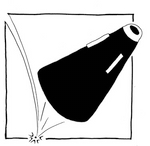
Drawing by Drew Owen
For the last several years, the Governing Board has been putting an emphasis on advocacy. Articles have appeared in this publication, presentations at the annual conference have been solicited; even the conference’s overarching theme last August was “The Art of Advocacy”.
Although I have only been on the board for a short while, I am pretty sure that the main impulse behind this advocacy of advocacy is the perception that our culture is replete with voices of negativity about the present and future of our art form, and the realization that this negativity must be countered. But I think there is an equally important rationale for advocacy—it makes our art better and more effective.
I grew up in Madison, Wisconsin, and from early in my horn-playing career revered the Chicago Symphony and its brass section. The recordings I bought in high school and repeatedly listened to were theirs. When later we moved to Chicago for graduate school, and lived off stipends, we budgeted money for subscription tickets. I had taken lessons with three of the members of the horn section, and I felt a connection to the orchestra. I was a fan.
Of course, fans are commonplace in the world of professional sports. The fan base is actively cultivated, with players having twitter accounts and teams selling player jerseys. An entire section of the newspaper contains not just stories about the actual game, but human-interest stories about, and interviews with, individual athletes. While I am not equating the experiences of attending concerts and baseball games, I do think that our audiences—and prospective audiences—are making economic choices in how to allocate limited discretionary dollars among an ever-increasing array of entertainment opportunities. What will tip the balance towards buying symphony tickets instead of that premium cable subscription? A personal connection with members of the orchestra.
This is not my own great revelation—orchestras have been doing exactly this type of relationship-building for years. But with the advent of social media, we have the ability to take some ownership of this important function. A number of orchestras have made superb use of social media in the face of contentious negotiations (or lack thereof) with their managements, Atlanta and the MET Orchestra being the two most recent examples. Elsewhere in this issue, Randy Whatley describes how social media can be as effective as paid public relations in spreading a particular message.
But Facebook and Twitter should not be viewed merely as tools to be used during threatened or actual lockouts. They should be commonplace tools wielded by orchestras as often as their members use metronomes.
A brief survey of ICSOM orchestras last night revealed 35 (or two thirds) with their own “musicians of” Facebook pages, although a handful of these have had few recent postings. The other third of orchestras leave to their managements the opportunity for interaction with the audience.
Full disclosure: my own orchestra’s Facebook page is in its infancy, having debuted in January. But its birth was much easier than I anticipated, with some of the newer members of the orchestra willing and able to do the necessary work. Every ICSOM orchestra has the necessary expertise available in its membership to engage its audience through social media. I urge all of our members to use these tools to build relationships with their audiences. It won’t make you play better, but it will make the audience enjoy the performance more.





